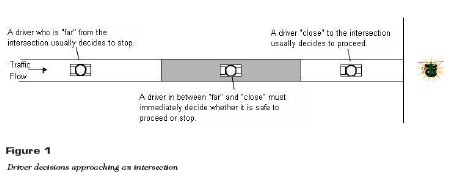Drivers approaching a traffic signal at high speed must decide whether to proceed or stop when presented with a yellow indication. This decision is based on each driver’s perception of whether it is safe (or possible) to stop prior to entering the intersection. This decision is illustrated in Figure 1. A driver in the shaded area in Figure 1 is said to be in the “dilemma zone,” where there is a range of driver reactions to the yellow indication. Some drivers will elect to stop, while others will decide to proceed. This difference in decision making can result in rear-end collisions. Other types of collisions are also possible, as are increases in red-light violations. The dilemma zone may also be different for different types of vehicles. The Detection-Control System (D-CS), developed at the Texas Transportation Institute (TTI), was designed to reduce the likelihood of vehicles being in the dilemma zone. D-CS has been successful in field trials in Texas, reducing red-light violations by 58 percent and intersection crashes by 39 percent. However, several possible enhancements of the D-CS control algorithm could not be investigated in the original research due to time and funding constraints. These enhancements could make D-CS even safer while still preserving the flexibility of the system. The final report is available from the National Technical Information Service (NTIS # PB2007-107338).
